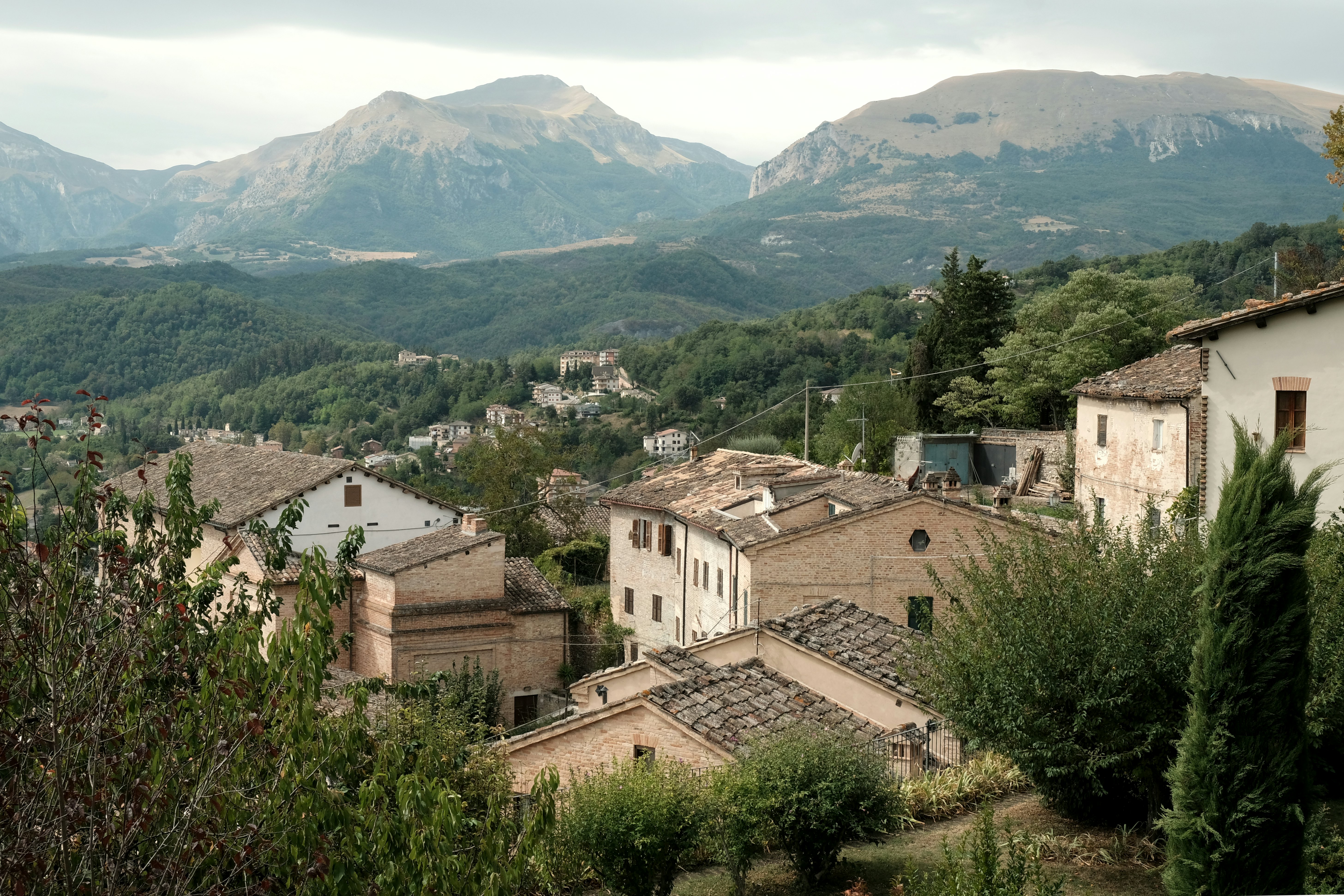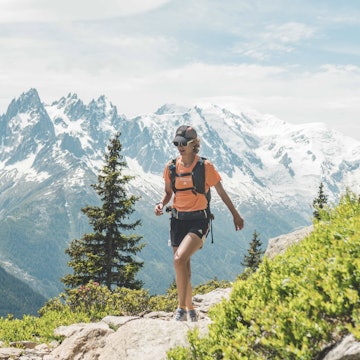

Local guide Mariano Constantini will be delighted to show you around the hills of Le Marche. Plan on taking your time © Joe Bindloss
The time to appreciate the tumbling terrain of central Italy is at dawn.
Set your alarm early, and a tableau of sculpted hills, steeply angled fields, scattered oak forests and medieval villages will materialize slowly from the gloom. As the sun eases slowly over the horizon, the vista will conjure up all the magic of a Renaissance painting.
Setting out before sunrise through the streets of San Ginesio – a delightful stone-built township in the hills of Le Marche – I could not have timed it better. As I reached the town’s medieval walls, hazy sunshine illuminated a landscape that could have been plucked from a fresco by Giotto, Raphael or Piero della Francesca.

The gateway to Le Marche
This lovely, overlooked province north of Rome could easily be mistaken for Tuscany – yet the lack of tour buses is an instant giveaway. The ancient townships of Le Marche are linked not by tourist coaches and high-speed trains but by trundling local buses. Slow travel is not just an option here: it comes with the territory.
The gateway stop for my circuit through the hills of Le Marche was the lowland city of Tolentino, a 1.5-hour train ride from Ancona – the region’s seaside capital, served by budget flights from London, Paris, Barcelona and other European hubs.
Tolentino is also easily accessible from Rome in 3.5 hours by Flixbus, or five hours by train (with a change in Fabriano). Whichever route you’ll take, you’ll quickly leave the tourist bustle behind, passing small villages of stacked stone houses that you’ll want to bookmark for future Italian adventures.
As I arrived in Tolentino, however, I felt a tinge of apprehension. Since my last visit to Le Marche, substantial earthquakes had rattled the region to its foundations, causing nearly 300 deaths and damaging thousands of homes and monuments. Had the charming, stone-built towns and villages that I remembered survived the disaster?

Le Marche, in microcosm
Strolling into the town’s historic center, I was initially reassured. The four astronomical clock faces of the arcane-looking Torre degli Orologi still rose above Tolentino’s historic Piazza della Libertà, and old-timers still crowded the cafes, sipping dainty cups of espresso and slurping gelato.
At opposite ends of the square, however, the Palazzo Comunale and Palazzo Sangallo were wrapped in hoardings while builders carried out the painstaking work of stabilizing structures weakened by the October 2016 tremors. It was a pattern I would see repeated across the region: some buildings were seemingly untouched by the disaster, with others shrouded in scaffolding.
Sadly, the region’s medieval churches, theaters and museums were particularly badly hit, meaning visiting Le Marche’s timeless townships is something of a game of chance. In some places, you’ll have to make do with admiring the 500-year-old palazzi and chiese from outside – though the ample photo opportunities provide generous compensation.

San Severino splendor
Before heading for the highlands, I made a short trip along the valley to the eye-catching town of San Severino Marche, accessible from Tolentino via a 30-minute bus ride or 18-minute train trip. Sprawling uphill from a low plateau, the town is famous for the teardrop-shaped Piazza del Popolo – one of the prettiest squares in central Italy – and its interesting clutch of community museums, including the Museo dell'Arte Recuperata Arcidiocesi Camerino (MARec), devoted to artworks rescued after the 2016 disaster.
Sipping a decaf espresso in a café by the Teatro Feronia, a Le Marche icon dating to 1747, I was struck by the general lack of scaffolding in the lower part of the town (though teams of restorers were still hard at work repairing the ornate interior of the baroque, brick-fronted Chiesa di San Giuseppe).
Following cobbled lanes toward the hilltop castello, with its honor guard of 15th-century monasteries and churches, I saw signs of restoration and repair, but also a town bouncing back from disaster. Not everything was open – yet – but recovery was well underway.
The balcony of the Sibillini
Since slow travel is a way of life in Le Marche, the journey south from Tolentino to the town of San Ginesio was suitably ponderous. Four buses a day wend their way through the green, farmland-covered hills to the edge of San Ginesio’s robust town walls, built for safety at a time when Italian nobles didn’t think twice about marching out to ransack the village next door.
Breaching the fortifications via the formidable-looking Porta Picena, I immediately noticed the stone arcade of the 13th-century Ospedale dei Pellegrini, constructed as a hostel for pilgrims visiting San Ginesio’s 100-or-so churches. Then I noticed the abundance of tower cranes rising between the church campanili (bell towers).
Known as the “balcony of the Sibillini” for its views of the surrounding Sibillini Mountains, this town of 3200 was hit hard by the 2016 earthquakes. Around two-thirds of its buildings sustained damage, and many houses and monuments remain wrapped in corsets of steel cables or propped up by intricate lattices of scaffolding poles and timber struts.
As I wandered along the historic streets, I heard the sound of hammering as builders worked to restore cracked masonry and bowing walls. Nevertheless, the town’s charm endured – something the United Nations World Tourism Organization recognized by selecting San Ginesio as one of its “Best Tourism Villages” in 2021.
Approaching the main town square from the Auditorium Sant’Agostino – a former monastery and school pressed into service as a temporary home for Renaissance-era paintings rescued from the town’s earthquake-damaged churches – I passed tall townhouses, towering church spires and cobbled lanes that cascaded down the hillside like tangled pappardelle.

Community-based recovery
Pausing for a scoop of gelato surrounded by coffee-breaking builders in front of the bud-shaped spires of the 11th-century Chiesa Collegiata di Santa Maria Assunta, I was struck not only by the destructive force of the 2016 disaster, but also by the sense of people pulling together – something confirmed when I spoke to the town’s deputy mayor, Daris Belli.
“The immediate feeling after the disaster was of fear, and anxiety about the loss of certainties, habits and homes, but the earthquake brought the community together,” he explained. “While reconstruction has been slow, people have stepped up to provide emotional and psychological support, and tourism is playing a fundamental role in revitalizing San Ginesio.”
The mayor’s office is spearheading community-based tourism as a route to recovery, putting local cafe and B&B owners, artisan producers, farmers and experts on local history at the heart of the visitor experience. The town’s tiny tourist office, tucked under the arches of the imposing Teatro Comunale di Giacomo Leopardi, can arrange all sorts of excursions that let visitors interact with area residents.
Exploring the gateway to the underworld
I took them up on the offer of a walk around the green uplands of nearby Monti Sibillini National Park in the company of Mariano Constantini, an energetic mountain guide with a voluminous Gandalf beard and a tangible passion for the hills. As we walked, he told me of his adventures trekking over, climbing up and paragliding off the summits in the Sibillini range.
Viewed from a distance, the steep-sided peaks rise against the horizon like grasping fingers, brooding with promise – and just a hint of menace. According to local folklore, the mountains guard a gateway to the underworld, sheltering a mysterious prophetess who once lured local menfolk to their doom. Today, the forested, cyclamen-dotted gorges and bald summits are better known for hiking, paragliding and skiing, but the mountains still hold dangers, with strong winds and frequent avalanches in winter.
As we looked out over a vast sweep of Le Marche countryside from the paragliding launch site above Sarnano, Mariano exclaimed, with passion, “When taking off from here, we go as high as we can breathe, but you have to be careful. There are many ways to hurt yourself in the mountains; if the conditions aren’t right, stay at home by the fire!”
We finished up a day of wandering on the shores of Lago di Fiastra, a gorgeous lake created by a hydroelectric project in 1955. Thanks to the lake’s chalky white bed, the water gleams an almost Caribbean turquoise, and we joined a friendly gaggle of locals swimming and eating at the osterie (casual restaurants) clustered at the lake’s southern tip.

Onward to Sarnano
After a comfortable night in San Ginesio’s Albergo Centrale hotel – which is awaiting new owners after being restored by the town authorities – I resumed the village-hopping, following a winding route along the fringes of the national park to the postcard-perfect village of Sarnano.
Don’t underestimate the time it takes to travel around this part of Italy: public buses run by Contram Mobilita SCPA and Autolinee SASP connect most villages and towns, but there are just a few services a day on most routes (and none on Sundays), and villages that look next to each other on the map can be an hour apart once you factor in the hilly terrain. (I did say slow travel was a way of life here!)
Treat it as a nudge to take your time. These enchanting villages are there to be savored, for wandering aimlessly through tangled laneways, snapping photos of ornate doorways and plunging stairways, settling in with a novel in quiet village squares and daydreaming while taking in the mountain views.
And Sarnano is a true beauty – coiled around a conical hill and only lightly touched by the 2016 disaster. Wandering uphill from the bottom of town, I navigated a maze of neatly cobbled lanes that would have made MC Escher proud, with each turn revealing another view squeezed between lantern-decked, terracotta-colored houses.
The town topped out at the suitably named Piazza Alta, flanked by the grand frontage of the under-repair Teatro della Vittoria – which looked more like a palace or cathedral than a mere theater. With work on the building still underway, I had to make do with ducking inside the town’s stately churches, starting with the Romanesque Chiesa di Santa Maria di Piazza Alta on the hilltop.

Renaissance grandeur and a preserved saint
Several buses a day trundle south along the valley from Sarnano, but the short trip to the similarly charming town of Amandola is also easy to cover by taxi. (Outside of the summer season, this may be your best option; ask the Sarnano tourist office on Borgo Giuseppe Garibaldi for assistance.)
When I arrived in Amandola, I was tempted to head straight uphill from the market square. But acting on a local tipoff, I stopped first at the imposing Chiesa di Sant'Agostino to view the moody frescoes and the desiccated, nose-less mummy of 15th-century Franciscan friar Beato Antonio – infamously desecrated by Napoleon’s forces.
A calf-straining walk through the old town dished out more classic Le Marche views: cobbled lanes lined with stately brick mansions, archways opening onto slanted squares, and soaring views of the Monti Sibillini range (particularly from the hilltop Parco Giochi Belvedere).
I plotted a route via the graceful Teatro La Fenice, constructed in the 17th century and revamped in 1819, and the 14th-century Chiesa di San Francesco, which houses a museum devoted to the lives of the people of Sibillini (a carved dragon and bear spew vines on either side of its Gothic doorway).
Sadly, both were closed for earthquake repairs – but the beauty of travel in Le Marche is that there’s always another village to explore. Within easy taxi distance of Amandola, dignified Montefortino offered front-row views of the dramatic, rock-faced Infernaccio Gorge and dainty Monte San Martino looked longingly toward the mirror-image village of Penna San Giovanni across the valley.
The end of every trip to Italy? A memorable meal
I wrapped up my village circuit at the green and serene Lago di San Ruffino, a man-made lake on the doorstep of the Roman-founded Abbazia dei Santi Ruffino e Vitale. A faint whiff of sulfur provided a reminder of the thermal springs that first drew Italy’s most famous empire builders to these undulating valleys.
No trip to central Italy would be complete without a slow, languorous meal, and the lakeside Osteria del Lago cooked up a treat – pasta amatriciana, with fresh tomatoes, guanciale (cured pork) and local cheese, and an antipasti platter piled high with prosciutto crudo, ciauscolo (spreadable salami) and lonza (cured pork filet), with vino cotto (“cooked” wine) and crisp hazelnut biscotti for afterward.
Squisito! Le Marche perfection.
Joe traveled to Le Marche on the invitation of the UNWTO and the San Ginesio Municipality. Lonely Planet does not accept freebies in exchange for positive coverage.
















